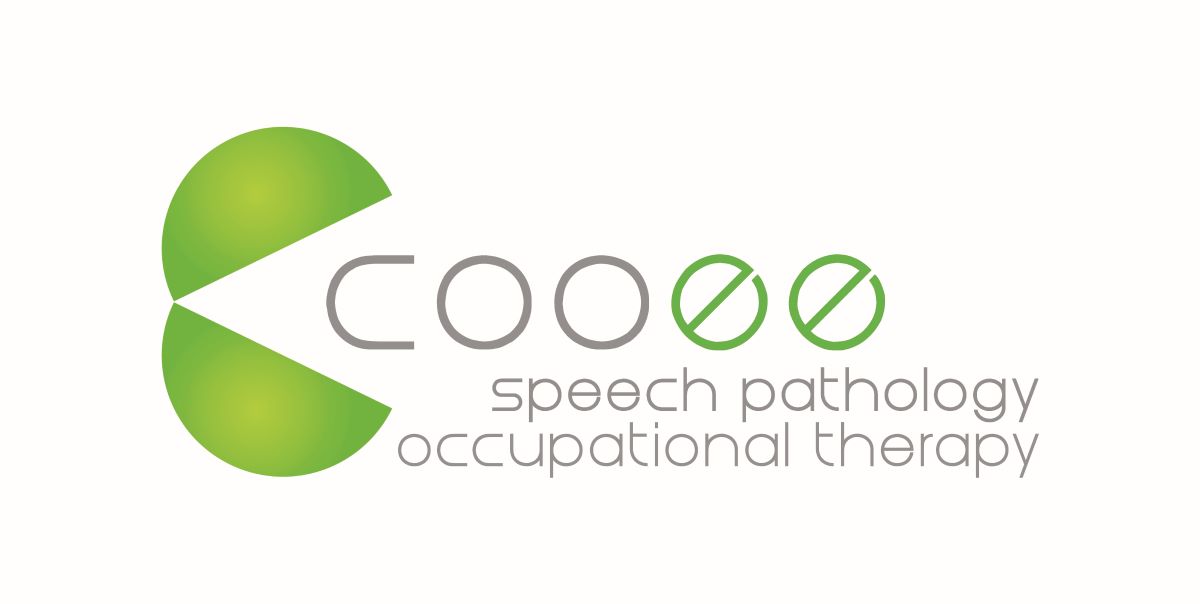Developing Language at Home
As Speech Pathologists, a large part of our role is working with families to provide recommendations that help parents and carers continue to support children’s language development at home.
Here are our favourite, evidence based strategies you can use at home to support your child’s language development across developmental stages from birth to preschool years.
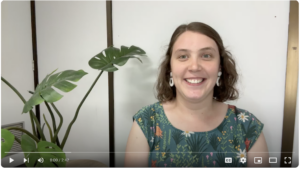
Want to watch this content instead of reading? Click below to head to Youtube!
VIDEO – Language Learning at Home with Speech Pathologist, Tess
Supporting children to develop early communication skills:
Below are some strategies our speech pathologists recommend using with young children to support engagement and early language skills which generally develop before a child uses their first words.
Delight
General interactions between children and their carers should be filled with delight and love. Back and forth circles of communication, including non verbal gesturing is the goal. To encourage interaction, and language, choose activities which promote love and delight, and include your child’s interests.
Activities like bubbles, playing with balls, tickles and raspberries are often good starting points. In early conversations we aim for lots of laughter, sound making, and good eye contact, with the child starting the game again when you stop.
Waiting
It seems so simple, but waiting is an important tool for getting your child to talk!
Waiting gives your child time to think and respond to what you’ve said or done.
When you wait it’s important to stop talking, and look at your child expectantly. Counting slowly and to 10 in your head can be helpful. Once your child responds to you with a word, sound, or gesture, respond immediately with interest.
Try not to fill the silence with more questions, or repeating yourself! Simply make a comment, WAIT, and LOOK expectantly with a gesture to indicate it is your baby’s turn in the conversation.
Special Time Together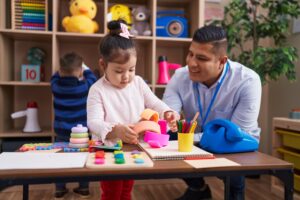
Dedicate special time each day to 1:1 conversations with your baby or toddler.
Spend time looking at bright and colourful books, playing peekaboo, anything that can get you face to face and sharing attention with a simple object.
It’s important that your child can see your face, as well as look at the object with you together. Having daily time together reinforces how special communication is, and gives you a daily opportunity to practice language strategies.
If your child is not yet saying their first words – read here about the skills that children develop before using their first words, see this blog!
Or for more information on early communication and engagement, see this blog!
Supporting Children to develop their first words
While doing some recent clinical research on early language development, I came across the term “Language Bubble.” It instantly brought to mind an image of a child growing and developing surrounded by a warm glow of words and language.
Children develop language by taking in what they hear and see around them.
This provides parents and families with opportunities to shape the “language bubble” around their child to provide a rich language environment.
Below are some strategies speech pathologists recommend using with children who are beginning to talk, to strengthen their language bubble and support their development.
Self talk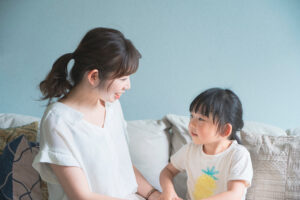
This strategy includes commentating what you (as the parent or carer) are doing with your child in routines and daily activities. This is a great way to increase the amount of language babies and young children are hearing. For example while you’re getting dinner ready, you might say “I’m mixing the sauce” or “mummy’s scooping the pasta”.
Never assume a word is too ‘big’ or ‘adult’ for a child to benefit from learning.
Let your child lead
We all like to talk about things that we find interesting and young children are no different.
When using these strategies to encourage your child to talk and use more words, first let them take the lead and choose what to play, as your child may feel more motivated to communicate about an activity they enjoy. It is also a great way to model words and phrases they are interested in.
Letting your child lead & attuning your interest to them, indicates that you are present in the play and ready to explore with them, through your connection.
Modeling
Modeling is a fantastic way to expose your child to new words and encourage their use – and it is likely something you already do everyday! Children learn language by listening to people around them and copying what they hear.
You can model new words by using them in play and conversation with your child.
Some familiar examples of modeling include: pointing to toys or objects and saying the word, or saying “up” when your child extends their arms to be picked up. Next time your child is having a bath or on the change table, hold up the item (nappy, soap) and name it for your child.
Don’t forget also – to mix up your modeling – make sure you are weaving in a range of different types of words into your language bubble. Try to include not just labels of objects (cat, mum, ball) but also actions (go, stop, push), negation (gone, no) and other meaningful words that correlate strongly with everyday life activities (like up, more, again, where, my turn) etc.
It’s a good idea to model just one small step ahead of what your child is using expressively, so it’s easy for them to hear + copy. Also to model slowly, so they can see your mouth move if they are really young – but always model the correct grammar. No need to cut out the little ‘filler’ words!
For suggestions on toys to use at home see this blog!
Supporting Children to begin combining words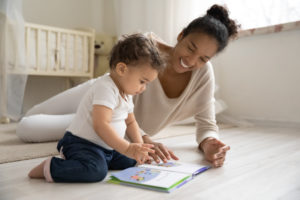
As Speech Pathologists we often work with children whose language development has become stuck at the single word level. These children may have a lot of single words, they may use words to name people and objects in their life, and use these words for a variety of reasons, but are not yet putting words together.
When we work with the child’s family and begin exploring the types of words in their child’s vocabulary, we find that while they have a lot of naming words (nouns) they don’t use a lot of action words (verbs) or describing words (adjectives).
Below are some strategies speech pathologists recommend using with children to support them to begin combining words to make phrases and sentences.
Expansion
Language expansion is taking what the child has said and providing a model at the next stage of development. This provides an example of exactly how your child could combine words to communicate their message.
For example if you are driving to school or daycare and your child says “car” you could expand to “we are in the car” or “driving in the car.” Simply try adding some more to the start or the end of your sentence.
You can also use new question types to help with making longer sentences – e.g.by asking questions – we can turn “car” into..
What kind/with what? car –> my car –> my blue car –> my big blue car —> my big blue car with wheels!
Where? car –> in the car –> in my seat in my car –> in my seat, going to school, in my car!
Doing what? car –> driving in the car –> driving on the road –> driving on the road, in my car!
Who? car –> mummy is in the car –> sammy is in the car –> mummy and sammy are in the car!
Questions that follow the ‘wh’ format, are generally more powerful for modeling language than closed descriptive questions like ‘what colour is this’, or using flashcards to expand language.
The value of verbs
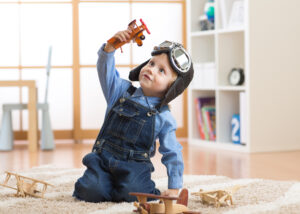 Whether it’s talking about a movie we saw, a meal we ate, or a person we spoke to, action words (verbs) are a crucial part of how we express ourselves. So when a child has mostly naming words but few action words in their vocabulary, the child often uses a single word “juice”, rather than combine that naming word with another word, (e.g. an action word), to create a two word phrase such as “drink juice”.
Whether it’s talking about a movie we saw, a meal we ate, or a person we spoke to, action words (verbs) are a crucial part of how we express ourselves. So when a child has mostly naming words but few action words in their vocabulary, the child often uses a single word “juice”, rather than combine that naming word with another word, (e.g. an action word), to create a two word phrase such as “drink juice”.
Continue using language strategies of modeling, expansions and self talk with your child, with a focus on using action words (verbs). When cooking, try using self-talk to commentate on how you are “cutting”, “mixing” and “tasting”. During bathtime, try modeling action words to comment on how the child is “splashing”, “pouring water” or “washing”.
Some children require more specific and individualised support to develop their language skills. In fact research shows that 7-10% of Australian Children have a Developmental Language Disorder. That’s one in every fourteen children. For more about Developmental Language Disorder – head to www.thedldproject.com .
If you have questions about your child’s early language development please contact us on 3265 4495, email [email protected] or book a clinical journey planning session with one of our Speech Pathologists.
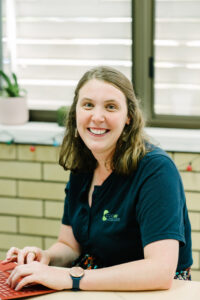
Written by Tess Marson, Speech Pathologist
